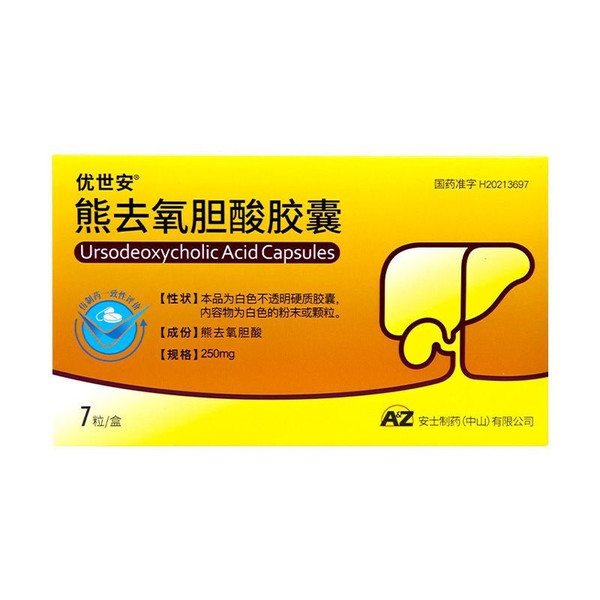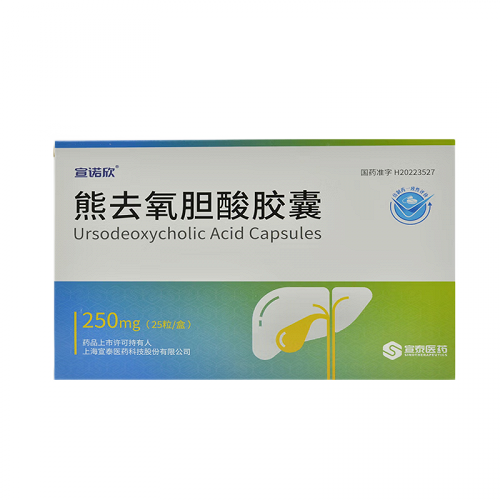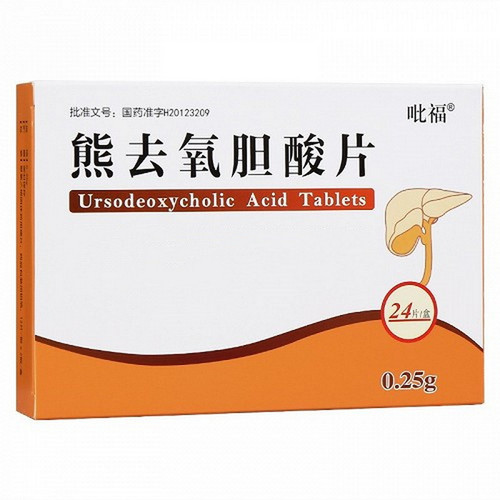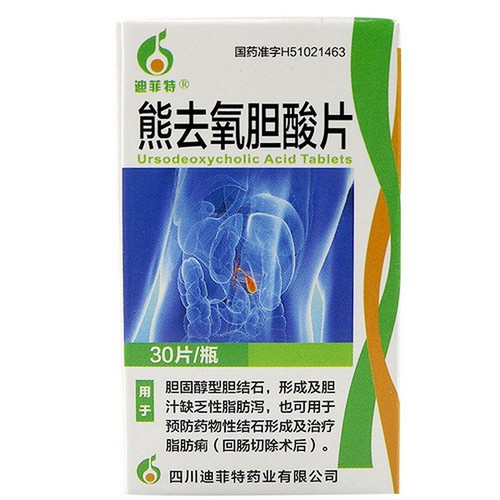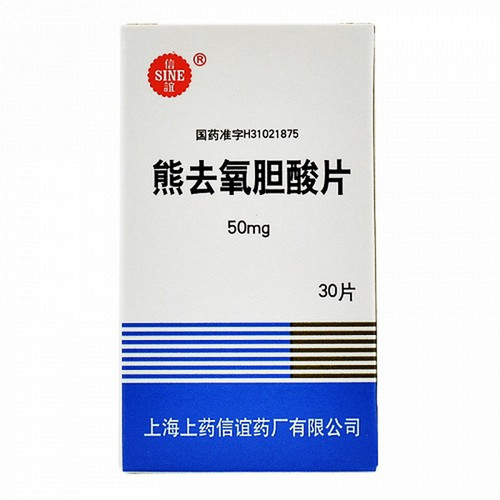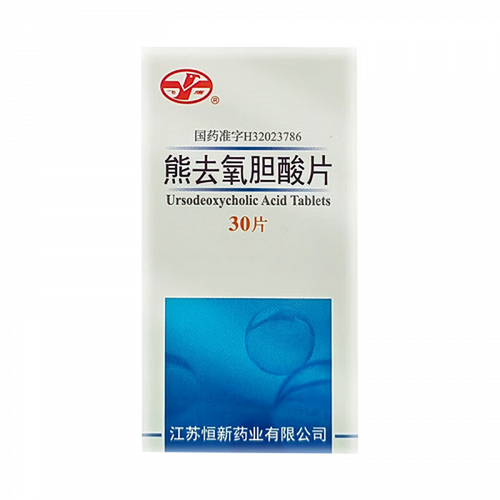Product Overview
[Drug Name]
Generic Name: Ursodeoxycholic Acid Capsules
Trade Name: Youshian
English Name: Ursodeoxycholic Acid Capsules
Chinese Pinyin: Xiongquyangdansuan Jiaonang
[Ingredients]
Chemical Name: 3α,7β-dihydroxy-5β-cholestane-24-oic acid.
[Properties]
This product is a white, opaque, hard capsule containing white powder or granules.
[Indications]
1. Cholesterol gallstones—must be X-ray-translucent and have normal gallbladder contraction function; 2. Cholestatic liver disease (e.g., primary biliary cirrhosis); 3. Bile reflux gastritis.
[Dosage and Administration]
1. For patients with cholesterol gallstones and cholestatic liver disease, take the drug regularly with a small amount of water. The daily dose is 10 mg/kg body weight. Litholytic treatment: Generally, it takes 6 to 24 months. If the stone does not shrink after 12 months, discontinue treatment. Treatment results are assessed by ultrasound or X-ray examination every 6 months. 2. Bile Reflux Gastritis: Take one 250mg tablet with water at night before bed. It must be taken regularly, once daily. It is generally taken for 10 to 14 days. Continue taking the medication according to your doctor's advice.
[Adverse Reactions]
Gastrointestinal Disturbances: In clinical trials, loose stools or diarrhea were common with ursodeoxycholic acid. Severe right upper abdominal pain is rare in the treatment of primary biliary cirrhosis. Hepatobiliary Dysfunction: Calcified gallstones are rare with ursodeoxycholic acid. Decompensated cirrhosis is rare in the treatment of advanced primary biliary cirrhosis, with partial recovery after discontinuation of treatment. Allergic Reactions: Urticaria is rare. [Contraindications] Ursodeoxycholic Acid Capsules are contraindicated in the following conditions: - Acute cholecystitis and cholangitis; - Biliary obstruction (common bile duct and cystic duct); - Recurrent biliary colic; - Radiopaque calcified gallstones; - Impaired gallbladder function; - Gallbladder invisibility on X-ray; - Hypersensitivity to bile acids or any of the ingredients in this product.
[Precautions]
Ursodeoxycholic Acid Capsules must be used under medical supervision. The attending physician should monitor liver function tests, such as AST (SGOT), ALT (SGPT), and γ-GT, every four weeks for the first three months of treatment and every three months thereafter. In addition to distinguishing responders from non-responders in patients with primary biliary cirrhosis, this monitoring can also detect potential liver function deterioration early, particularly in patients with advanced primary biliary cirrhosis. When used to dissolve cholesterol gallstones, to evaluate treatment efficacy and detect gallstone calcification early, a gallbladder x-ray (oral cholecystography) should be performed 6 to 10 months after treatment, depending on gallstone size. X-rays should be taken in the standing and lying positions (with ultrasound monitoring).
[Use in Special Populations]
Precautions for Children:
Dose according to weight and medical condition, or as directed by a physician.
Precautions for Pregnancy and Lactation:
Animal studies have not shown an effect of ursodeoxycholic acid on fertility (see [Pharmacology and Toxicology]). No human data are available on the effects of ursodeoxycholic acid treatment on fertility. Animal studies have shown embryotoxicity when ursodeoxycholic acid is used in early pregnancy. Human data during the first trimester of pregnancy are currently lacking. Women of childbearing age should use ursodeoxycholic acid capsules only after using safe contraceptive measures. Pregnancy must be ruled out before starting treatment. For safety reasons, ursodeoxycholic acid capsules should not be taken during the first trimester of pregnancy. Non-hormonal or low-dose oral estrogen contraception is recommended. However, patients taking ursodeoxycholic acid capsules for gallstone dissolution should use effective non-hormonal contraception, as oral hormonal contraception may increase gallstone formation. Based on the limited data available from lactating women, ursodeoxycholic acid levels in breast milk are extremely low.
Precautions for Elderly Patients:
Use with caution in elderly patients.
[Drug Interactions]
Ursodeoxycholic acid capsules should not be taken concurrently with cholestyramine (cholestyramine), colestipol (corstenolol), or antacids containing aluminum hydroxide and/or montmorillonite (aluminum oxide), as these drugs can bind to ursodeoxycholic acid in the intestine, hindering absorption and potentially compromising efficacy. If these medications must be taken, ursodeoxycholic acid capsules should be taken two hours before or two hours after taking these medications. Ursodeoxycholic acid capsules can affect the intestinal absorption of cyclosporine. Patients taking cyclosporine should monitor cyclosporine serum concentrations and adjust their cyclosporine dosage if necessary. In some cases, ursodeoxycholic acid capsules can reduce the absorption of ciprofloxacin. In clinical studies conducted in healthy subjects with coadministration of ursodeoxycholic acid (500 mg/day) and rosuvastatin calcium (20 mg/day), rosuvastatin calcium plasma concentrations were slightly increased. The clinical relevance of this interaction with other statins is unknown. Ursodeoxycholic acid can decrease the peak plasma concentration (Cmax) and area under the curve (AUC) of the calcium channel blocker nitrendipine in healthy subjects. Therefore, close monitoring is recommended when nitrendipine and ursodeoxycholic acid are coadministered. Increased nitrendipine doses may be necessary. Based on these observations, a single report of an interaction with dapsone (reduced therapeutic effect), and in vitro and in vivo studies, ursodeoxycholic acid has been hypothesized to induce the drug-metabolizing enzyme cytochrome P450 3A4. However, induction was not observed in well-designed interaction studies with budesonide, a known cytochrome P450 3A substrate. Therefore, caution should be exercised when coadministering drugs metabolized by this enzyme, and dosage adjustments should be made as necessary. Estrogens and cholesterol-lowering drugs, such as clofibrate, can increase hepatic cholesterol secretion and thus may exacerbate gallstones, contrary to the gallstone-dissolving effect of ursodeoxycholic acid.
[Pharmacological Actions]
Ursodeoxycholic acid constitutes a small fraction of human bile. Oral administration of ursodeoxycholic acid reduces cholesterol saturation in bile by inhibiting intestinal cholesterol reabsorption and reducing cholesterol secretion into bile. This may result in the gradual dissolution of cholesterol gallstones due to the dispersion of cholesterol and the formation of liquid crystals. Based on current knowledge, the efficacy of ursodeoxycholic acid capsules in treating liver and cholestatic diseases is primarily based on the relative replacement of lipophilic, detergent-like, and toxic bile acids with hydrophilic, cytoprotective, and non-cytotoxic ursodeoxycholic acid, as well as the promotion of hepatocyte secretion and immunomodulation.
[Storage] Store in a sealed container.
[Specification] 250mg*7 capsules
[Packaging] Box
[Expiration Period] 24 months
[Approval Number] National Medicine Standard H20213697
[Manufacturer] Company Name: Anshi Pharmaceutical (Zhongshan) Co., Ltd.
